Sir Alexander Baynham (1459-1524)
Born: 1459
Parents: Thomas Baynham of Clearwell and Margaret Hody
Married: 1483 to Margaret Vane and 1490 to Elizabeth Tracy
Died: 1524 at Westbury On Severn
Alexander was born in 1459, most likely at Mitcheldean in Gloucestershire.
He married Margaret Vane, daughter of Sir Richard Vane at the church of St. Peter and St. Paul in Westbury On Severn in 1483, when he was 24 and she was 23. They had one child: John in 1488. Margaret died in that year.
Alexander later married Elizabeth Tracy, daughter of Henry Tracy and Alice Baldington, at the church of St. George of England, Toddington in 1490, when he was 31 and she was 34. They had five children: Margaret in 1490; Ellen (Eleanor) in c.1491; Jane in c.1493; Thomas in 1495; James in 1499. Elizabeth died in 1527.
Alexander died at Westbury On Severn, Gloucestershire in 1524, aged 65.
It is possible that Alexander received the Manor of Westbury from his father Thomas on the occasion of his first marriage. What is clear is that he held it during his father’s lifetime because by charter dated 4th February 1489 Alexander placed it in the hands of trustees (his father Thomas, his brother William and his half-brother Christopher) to hold for himself and his heirs. He did likewise in 1513 with the Manor of Magna Dene and property in Dene Parva (Littledean) and Ruardene, placing them in the hands of William Tracy and others.
At some stage in his early life, probably aged around 21, Alexander was a member of Lyon’s Inn, one of the Inns of Chancery attached to the Inner Temple.
Lyon’s Inn was located near Wych Street and began life as a hostel ‘held at the sign of the lyon’ during the reign of Henry V. With records stretching back to 1413, it was originally a small and well respected Inn which had strong connections with gentry in the West Country and Wales.
Here Alexander would have been taught law, using moots and rote learning.
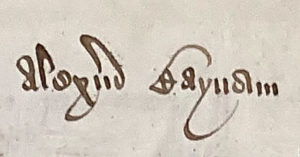
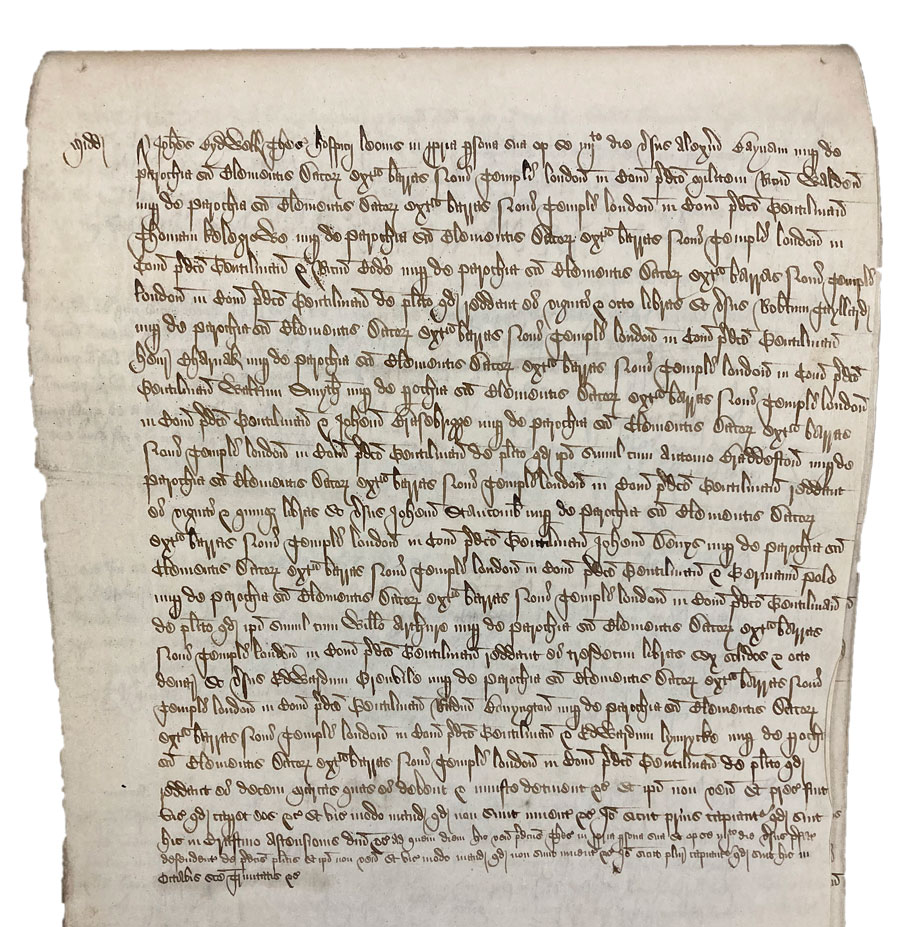
By age 23, Alexander was part of an English army which was mobilised by Edward IV in June 1482. Led by Richard, Duke of Gloucester (who within a year would be crowned King Richard III), this force of some 20,000 men invaded Scotland in July.
Alexander was knighted by Richard on 24th July 1482, ‘in Scotland, near Berwick’ – most probably at the army’s camp site at Hutton Field.
The town of Berwick opened its gates to the English army, allowing one division to remain there to lay siege to the castle, while Richard led the main force (including Alexander) north to Edinburgh, arriving on 31st July and returning to Berwick after just a few days’ negotiations. The castle was captured on 24th August; this led to the contemporary saying in England: “I was a captain when Barwycke was wonne”.
Alexander’s knighthood is recorded in a book of those knights who were made between 1413 and 1625, as compiled by Roger Glover (d.1588) – in the list for 1482, headed ‘Bannerettes made in Scotland the 24th day of July Anno Dmi 1482 … by the Duke of Gloucester’ in which he appears at number 13 of the 14 ‘Knights made the same day by the said Duke’.


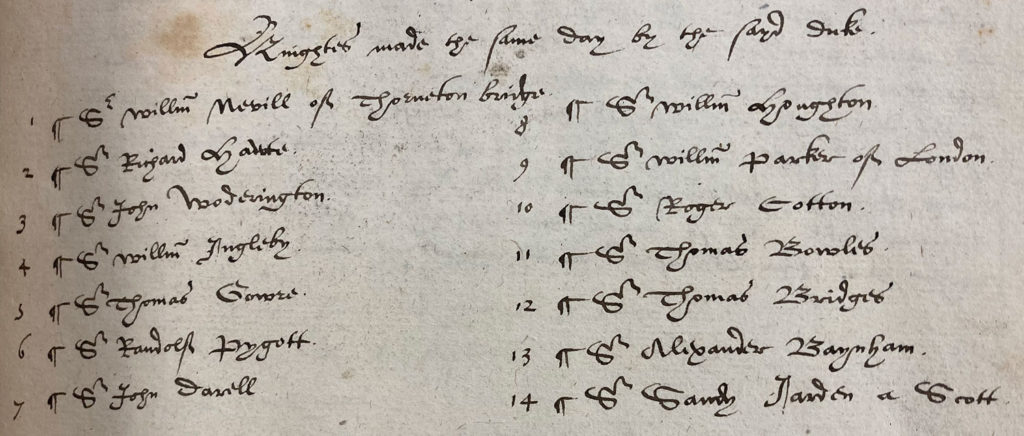
Later in the same year, Alexander was appointed Sheriff of Gloucestershire for the first of six times – on 5th November 1482, late in the reign of King Edward IV. He was recorded as ‘Alexander Baynam knight’.

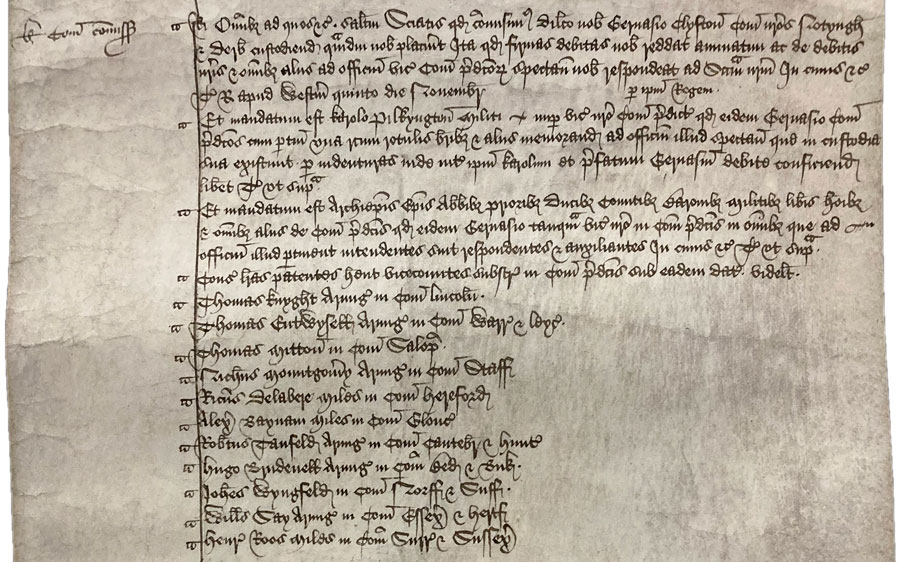
He was re-appointed Sheriff in early 1483, on 21st April, shortly after the accession of King Edward V on 9th April; this was the second of his six appointments as Sheriff – as ‘Alexander Baynam knight’.


He was re-appointed Sheriff again in mid 1483, on 26th June, the day Richard III became king. This was the third of his six appointments as Sheriff – again shown as ‘Alexander Baynam knight’.

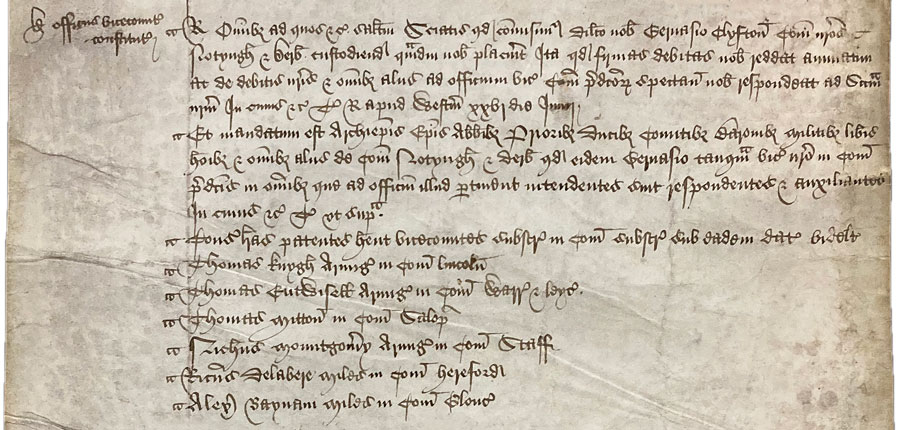
Also in 1483 (aged 24) Alexander married Margaret Vane, daughter of Sir Richard Vane at the church of St. Peter and St. Paul in Westbury On Severn [ insert brief details of Margaret’s pedigree ] .
This Patent Roll entry for 30th (sic) February 1484 contains a “Pardon to Alexander Baynham, knight, late Sheriff of Gloucester, of all offences committed by him, all escapes of felons and all fines, amercements, issues, debts, accounts and arrears due from him to the king”.

Throughout his life he sat on innumerable royal commissions – the earliest appear to be in 1484 when he was appointed alongside his father Thomas to two Commissions of Array in the county of Gloucester, on 1st May and 8th December.
In 1495 he was appointed to a Commission of Oyer and Terminer.
He also served on Commissions of the Peace for 30 years, from 1494 until just before his death in 1524.
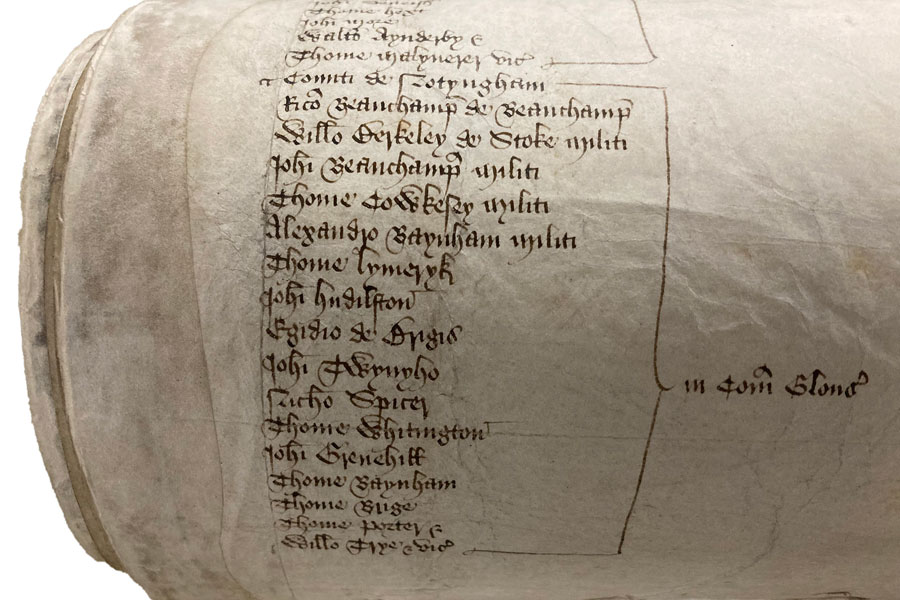

The Ballad of Bosworth Field (thought to have been written before 1495) suggests that in 1485 Alexander was away from home again, fighting for Richard III against the forces of Henry Tudor. The ballad mentions over a hundred lords and knights, among whom is Sir Alexander ‘Fawne’ who is believed to be Sir Alexander Baynham.
On 8th March 1486 Alexander became a Constable of St. Briavels castle when Henry VII made a “grant, in survivorship, to Robert Poyntz and Alexander Baynham, knights, of the office of constable of the castle of St. Briavels in the forest of Dene, co. Gloucester, from Michaelmas last, with the usual fees, wages and rewards by the hands of the bailiffs, receivers or other occupiers of the said forest and of the lordship of Newlond [Newland] in that forest”; this tenure lasted for 10 years.
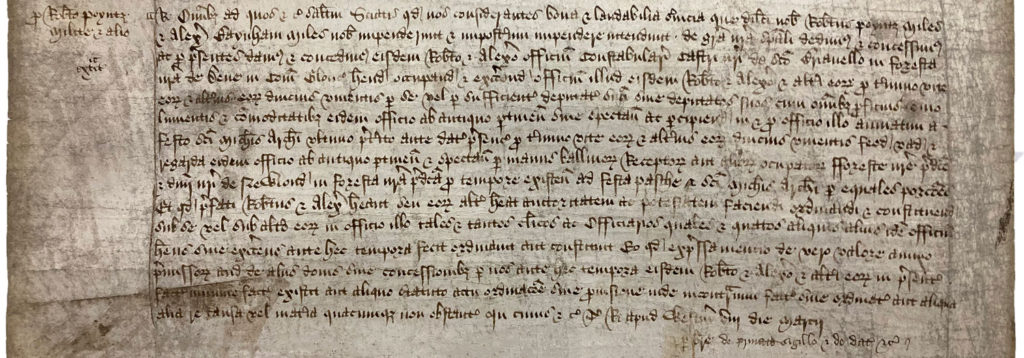
In 1488 Alexander and Margaret had their only child, John who as Sir John Baynham (1488-1528) was Alexander’s heir. Margaret most likely died in childbirth.
On 30th November 1488 Alexander, Walter Denys of Dirham and William Llewelyn of Pokelchirche in Gloucestershire entered into a bond for 200 marks payable to the king “at the Purification next”.
The bond was cancelled when the conditions were fulfilled.

In the bond, Alexander is described as Alexander Beynham of Westbury for the first time.

In December 1488, Alexander was one of the 8 knights for Gloucestershire commissioned along with the Sheriff “to summon all earls, barons, knights and other nobles in the county and to examine how many archers each is bound to find for the king’s army, and to take the musters of those archers preparatory to the expedition for the relief of Brittany; and to make the return of the premises to the king in person before the quinzaine of Hilary”. Four years later, Alexander was part of that expedition to France.
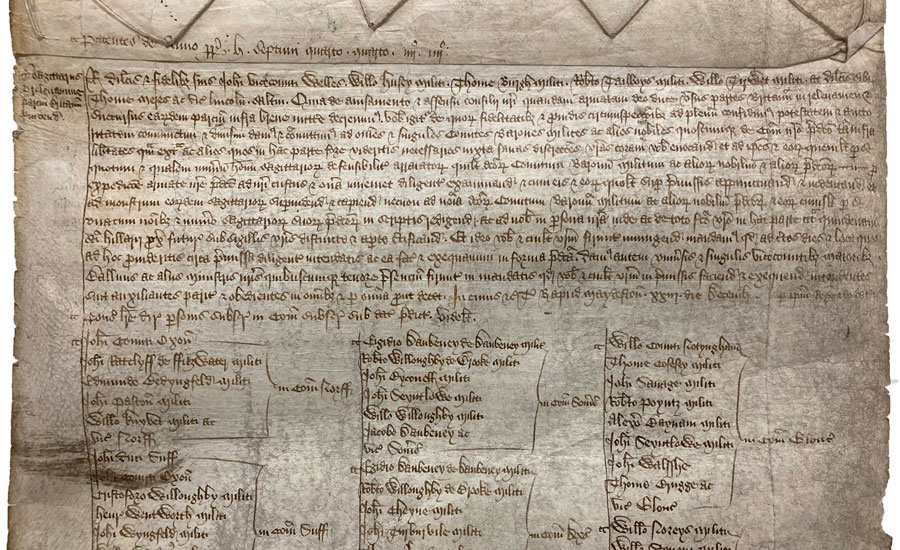
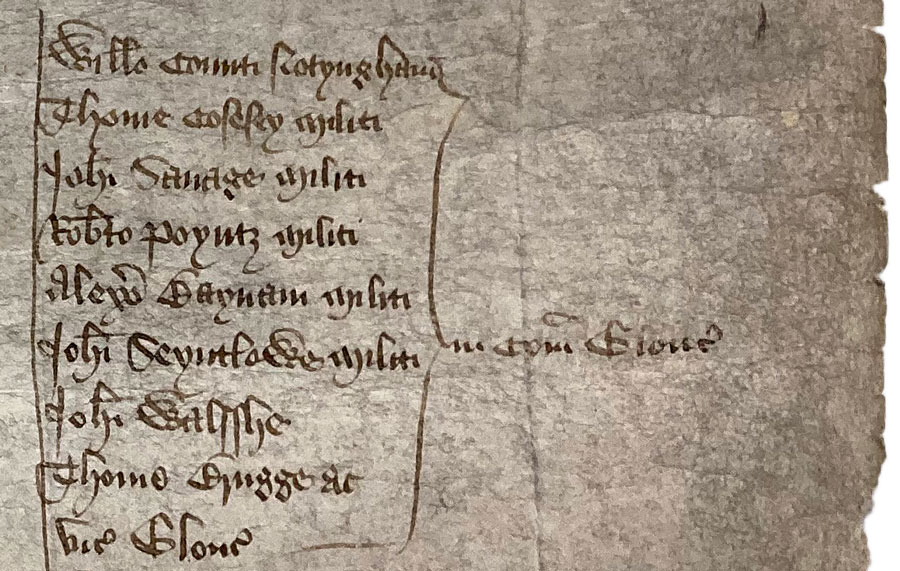
For 1489 records show a “Commitment (with like proviso) to Alexander Beynham, knight – by mainprise of Giles Brugges of Cowberly, co. Gloucester esquire and William Sargeant of Stone, co. Gloucester gentilman – of the keeping of the manor or lordship of Walsche Bykenor co. Hereford; to hold from Michaelmas last for 7 years, at a yearly farm of the 100s. for which answer has been made to the king and an increment of 6s. 8d. By bill of the treasurer. Dated 23rd February”.

In 1490 (now aged 31) he married Elizabeth Tracy, widow of Edmund Langley (d.1489) and daughter of Henry Tracy and Alice Baldington, at the church of St. George of England, Toddington [ insert brief details of Elizabeth’s pedigree ] . Together they had five children –
Their first child Margaret was born later the same year. She married John Peyto of Chesterton, Warwickshire (d.1542), as his second wife, and produced three sons – Alexander, Edmund and Francis – and four daughters – Audrey, Anne, Elizabeth and Mary. Margaret died in 1554.
Elizabeth produced another daughter Ellen (Eleanor) around 1491; she died in 1524.
An indenture dated 4th September 1491 between Thomas Baynham and Morgan Thomas and his wife Lucy enfeoffed Thomas, Alexander and William Baynham, William and Reynold Hody and Thomas Basshe in various manors and other properties. Lucy survived her husband and died on 24th January 1500. The IPM following her death again refers to Thomas and his two eldest sons.

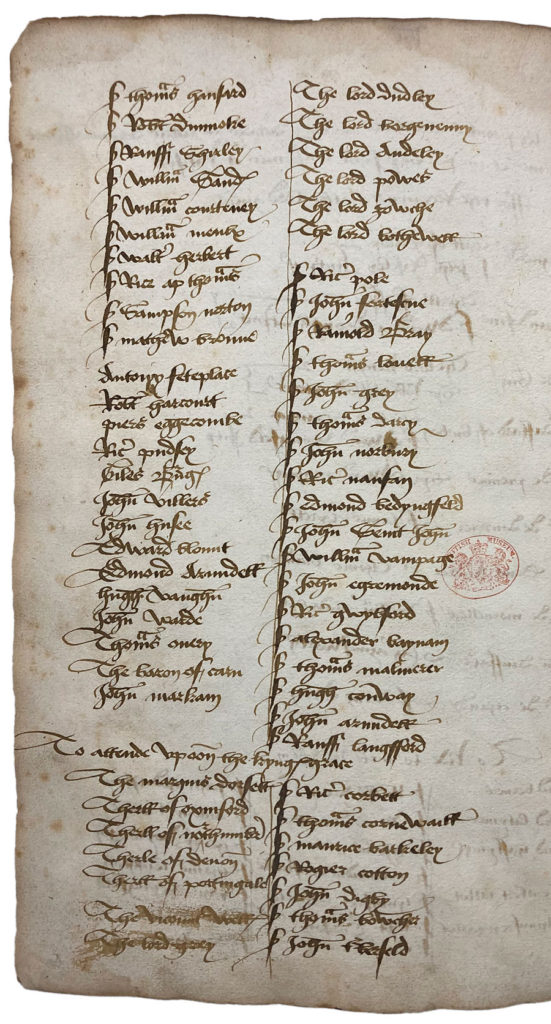
Alexander was with Henry VII when he invaded France with an army of 12,000 men and laid siege to Boulogne in the autum of 1492. Peace with Charles VIII of France was concluded quickly and the Treaty of Etaples was signed on 3rd November.
Henry appointed a small party of nobles, with interpreters, “for the recevying of the lord Querdes” (signatory for Charles), plus a group of 43 knights “to ride to mete with them” and a further group of 38 knights “to attende upoon the kynges grace”.

Alexander was a member of this third group.

The following year, Alexander Beynam, knight (‘alex beynam miles’) appears (as Recoverer), alongside his younger brother William (30), his younger half-brother Christopher (15) and others in an action in the Court of Common Pleas.


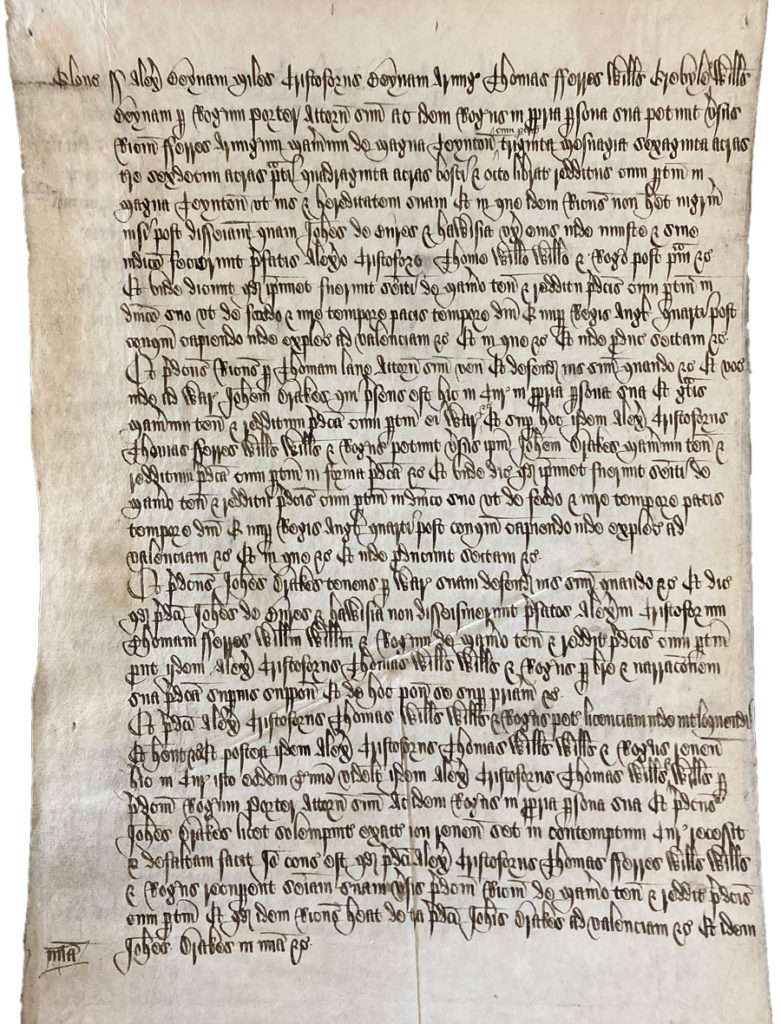
Around this time Alexander also appears as defendant in the Court of Requests in two cases – one brought by Robert Aylouth and his wife Agnes regarding a tenement in New Street in Great Dean;
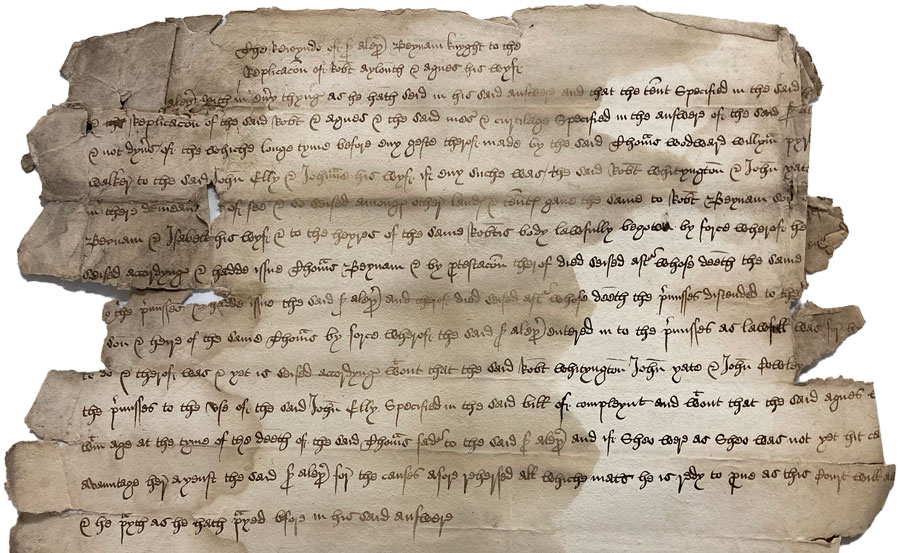
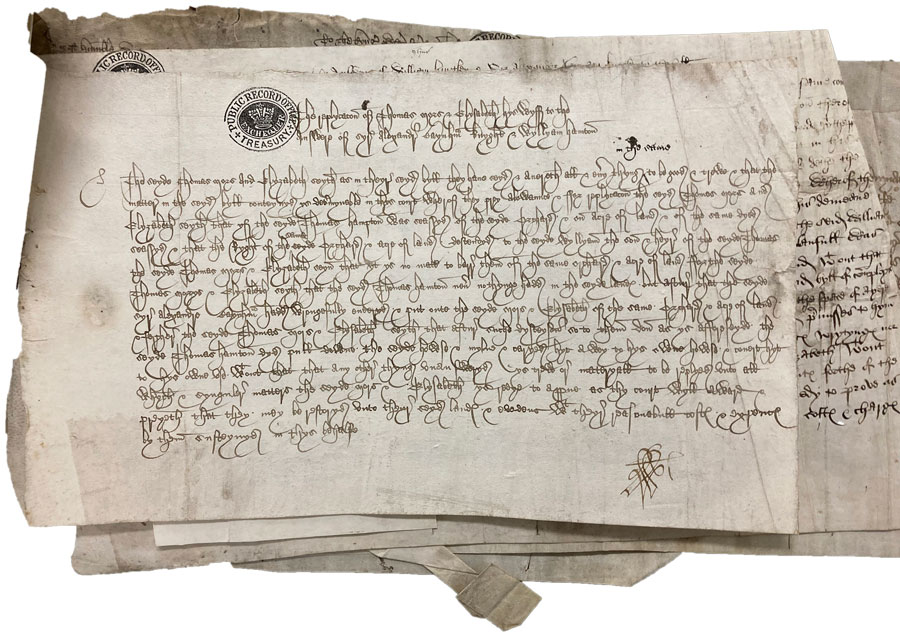
and another brought by Thomas Mors and his wife Elizabeth concerning a house, mill and land in Rodley, Gloucestershire.
A third daughter Jane was born to Elizabeth around 1493. She married twice – first Robert Wye of Over Lypiatt, Gloucestershire (d. 1544) as his second wife with whom she had seven sons and two daughters; and later Hugh Westwood MP of Chedworth, Gloucestershire but had no more children.
In 1495 Elizabeth produced a son Thomas; he left an interesting will when he died unmarried and childless in 1532.
On 7th April 1494 the three brothers Alexander, Christopher and William (along with their father Thomas and others) were recorded as feoffees of the manor of Puplyngton and other lands in the IPM of Robert Russell Senior. Robert had previously agreed with Thomas that his son and heir Robert Russell the Younger would marry Thomas’ daughter Elizabeth and in consideration of a sum of money paid to Robert Senior by Thomas he enfeoffed the Baynhams and others to the use of Robert the Younger and Elizabeth, now his wife.

Alexander also appears as a witness to a demise by charter made on 4th September 1494 by John Hewet of houses and land in Hidcote Bertram in Gloucestershire; the other witnesses are John Seyntlo and Walter Denys.
In 1495 an indenture made on 12th February between John son of Walter Berewe and William Beynam gentleman, provided that ‘the said John will before Christmas next enfeoff by deed Sir Alexander Beynam, Reynold Hody, John Broke and William Beynam in such lands etc. whereof the said Walter Berewe was seised to his use in St. Briavellys, Ettelowe, Blakeney and Aure parish in the forest of Dene in fee simple, to the use of John Berewe and Agnes his wife, with remainder Joan sister of John and her heirs, as specified, to be entailed in the marriage indenture of John and Agnes Berewe, between Walter Berewe and John Haresfeld father of Agnes; and in default of issue to them, to the use of William Beynam and his heirs, who is to receive 4s. a year of the profits of the hall until he be contented of seven marks, should Joan have issue; or else, if John and Joan prefer to keep the money, William shall have fee simple of the premises; provided that, if John be not agreeable to perform the payments, Joan shall have no benefit of the covenant; with mutual bonds of 40l.’
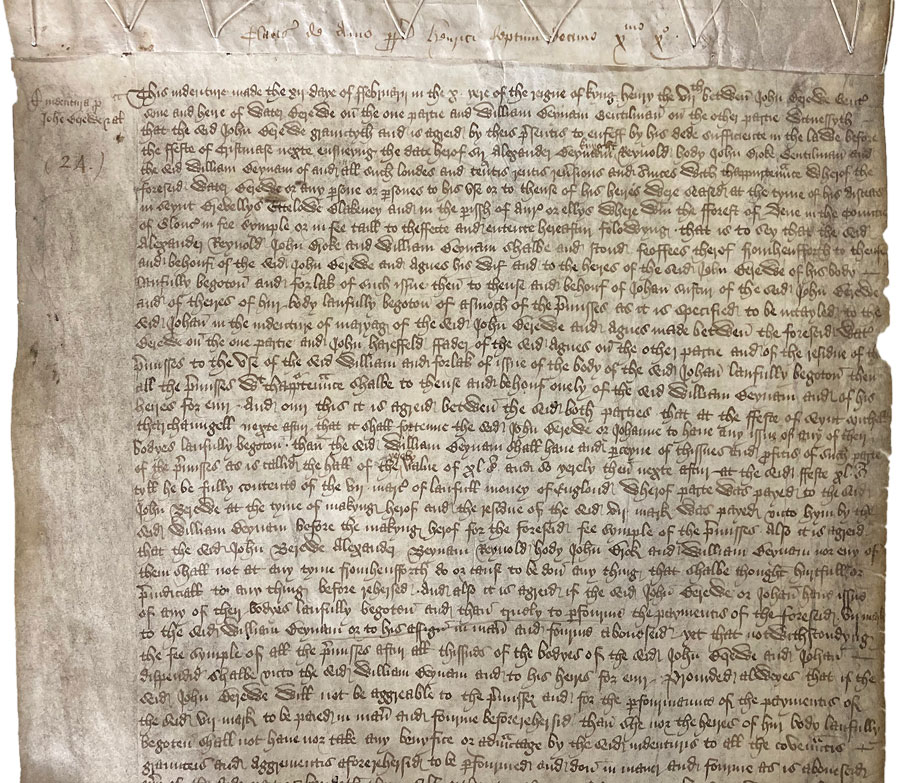

On 17th May 1495 Alexander, his brother William, Reynold Hody and John Brooke received a Remise and Quitclaim of various properties in the Forest of Dean and wider Gloucestershire from John Berewe, for a consideration of £100. A note of proclamations was endorsed on the reverse.
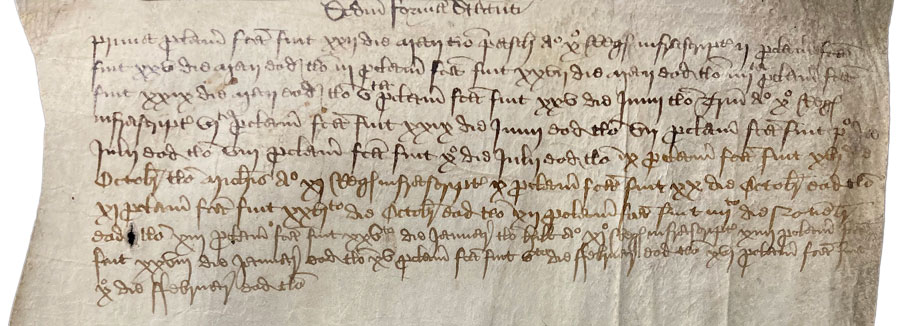

On 28th October 1496, the three brothers Alexander, Christopher and William (along with William Grevyle, Roger Porter and Thomas Ferrers) were again recorded as feoffees – this time, of the manor of Great Teynton in Gloucestershire in the IPM of Richard Ferrers.
In 1498 Alexander was appointed Sheriff of Gloucestershire for a fourth time – on 5th November, now shown as ‘Alexander Beynham knight’.

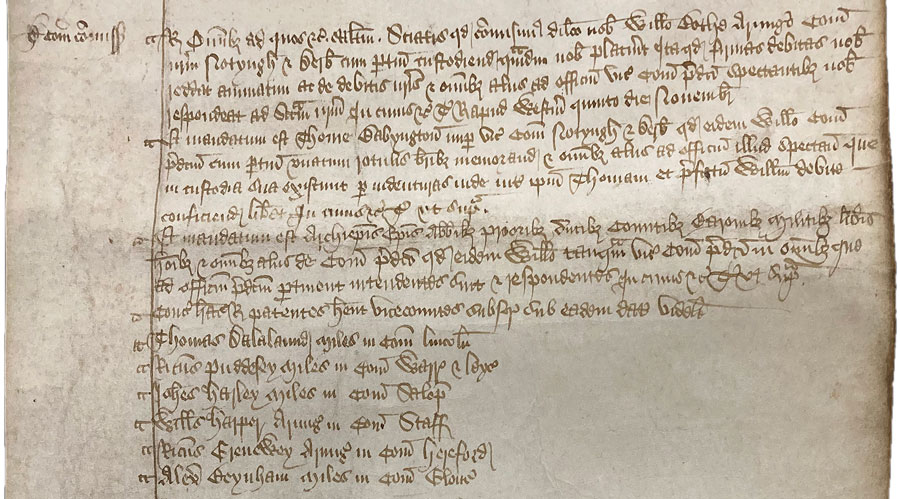
In the same year records show a “Commitment to Alexander Beynham, knight – by mainprise found before the treasurer and barons of the Exchequer – of the keeping of the manor or lordship of Walsche Bykenor co. Hereford; to hold from Michaelmas last for 20 years, at a yearly farm of the 106s. 8d. for which answer has been made to the king and an increment of 2s.; with the proviso for the increment of the farm. By bill of the treasurer. Dated 10th November”.

On 15th November 1498 Alexander received a re-grant of the office of Constable of the castle of St. Briavels: “Grant to Alexander Beynham, knight, of 10l. a year from Michaelmas last out of the issues of the manor of Came within the hundred of Berekeley, co. Gloucester, on condition that if he and Robert Poyntz, knight, surrender letters patent dated 8th March, 1 Henry VII [1486] and the king thereupon grants the office of constable to Alexander for life, or if the office come to Alexander by the death of Robert, these letters shall be void”.
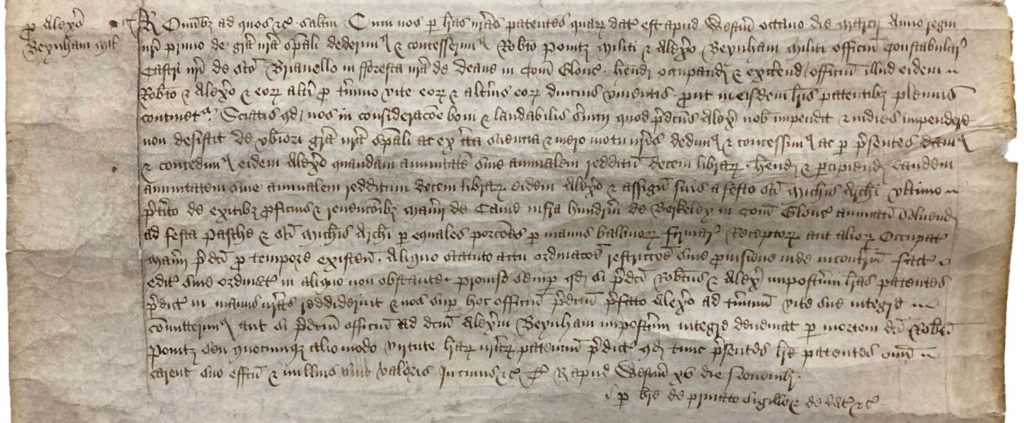
In 1499 their second son James was born. He became known as James Bainham the Martyr when he was burned at the stake for his religous beliefs at Smithfield, London in 1532.
Following the death of his father Thomas on 16th February, on 20th May 1500 Alexander, as son and heir, obtained a licence of entry without proof of age on to all Thomas’ lands.
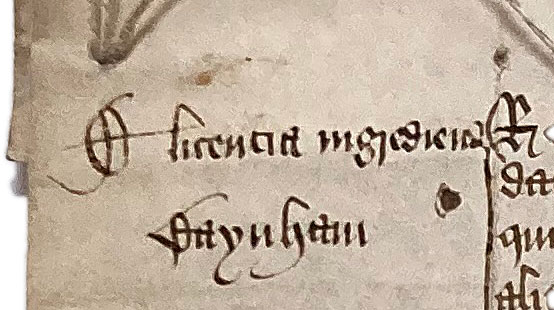
Presumably no proof was needed as Alexander’s age was already a matter of record in his father’s Inquisition Post Mortem; however, the IPM did not include Thomas’ property in Gloucestershire – hence the need for the licence.
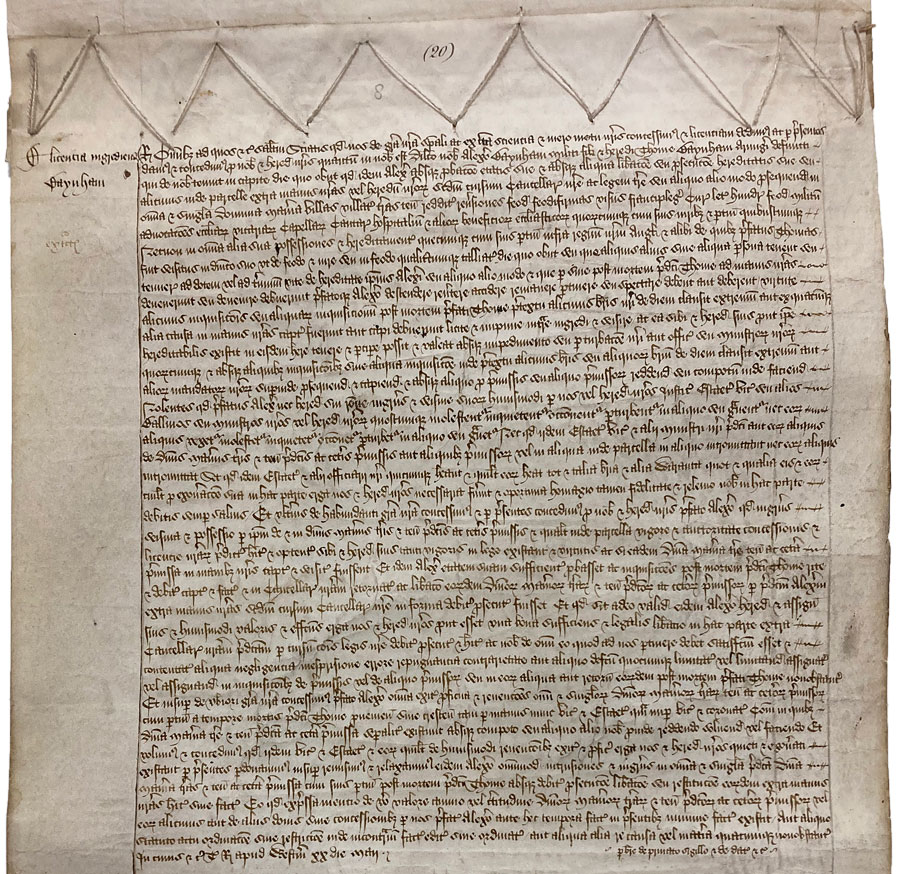
In the same year he was appointed to serve as a JP for Goucestershire, which he did until his own death in 1524.
In 1501 he was recorded as a witness to a release and quitclaim by John Clynton, on 9th February.

He was also included in the draft plan for the procession of Catherine of Aragon towards London following her arrival in England to marry Prince Arthur; as drawn up by Henry VII’s Council, for 8th November 1501 the plan reads: “Item, the Monday next ensuyng, which shalbe viij. day of November, the said princesse, accompanyed as afor, shall disloge from Chertesey, and drawe towardes Croydon, and ther in tharchbisshops place loge the next night ensuyng, and the Tuesday next day folowing. And between Chertesey and Croydon the said princesse shal be met with the personages following, that is to say, my lord of Buk, therle of Kent, my lord Fitzwarren, my lord Saintmond, the lord Stourton, my lord Dudley, thabbotes of Bury and [blank], Sir Waltier Hungerford, Sir Edward Darell, Sir Robert Harecourt, Sir Rogier Lewkenor, Sir Giles Bruges, Sir John Guys, Sir John Longford, Sir John Huddlestone, Sir Alexandre Bayneham, Sir John Rodney, and Sir Edmund Gorge, wherof thei shall have warnyng by my lord chambrelain”.
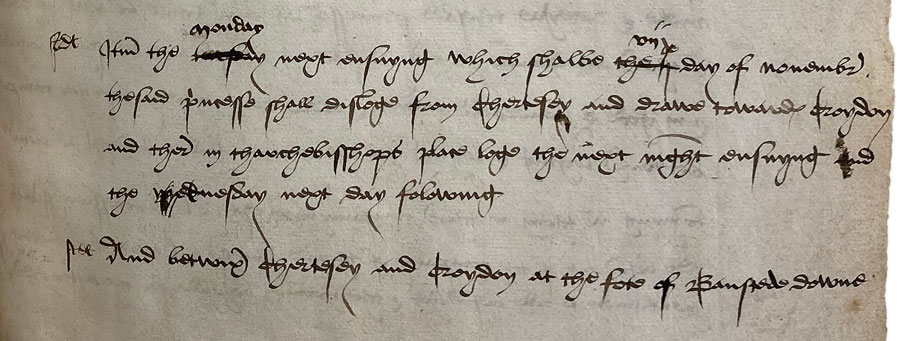

In 1502 Alexander was appointed Sheriff of Gloucester for a fifth time – on 8th November, recorded as ‘Alexander Baynam knight’.

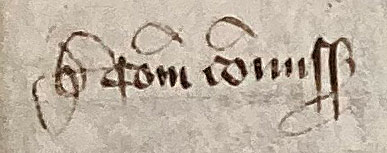
He also served for the year 1503-4.

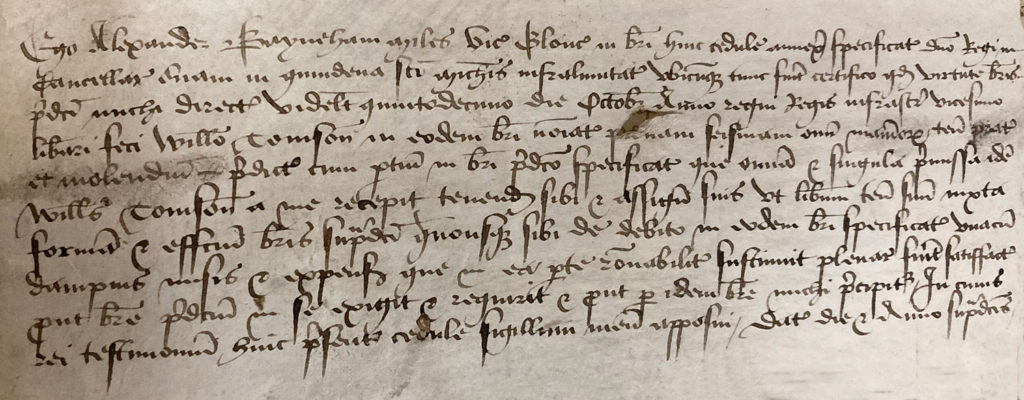
In early 1505 Alexander was entrusted with the wardship and marriage of Anne Mathew, one of the three daughters of Sir David Mathew and his wife Alice, both deceased; and with one quarter of the lands of which they were tenants in chief. All three girls were minors and co-heirs – Margaret and Elizabeth were made wards of Christopher Throkmerton and Richard Hord respectively.
Anne later married Alexander’s eldest son and heir John.

On 1st April 1506 he received a commission, along with three others for the county of Hereford and the marches of Wales, “to enquire of wards, marriages, reliefs, lordships, manors and lands belonging to the king concealed and of alienations, intrusions, idiots, alienations in mortmain and goods of outlaws, felons and fugitives”.

In early 1507 Alexander made one of four recognizances (with conditions attached) for 40l. each to the king jointly with Sir Robert Poyntz of Iron Acton and John Walsh of Wolveston before John, Abbot of St. Austin’s, Bristol, the king’s commissioner by virtue of a writ of dedimus potestatem.
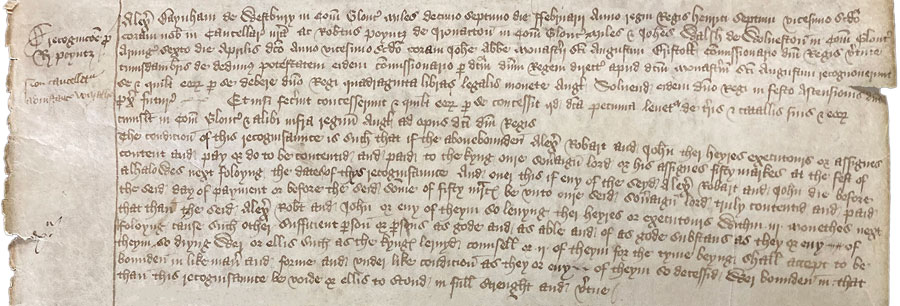

On 7th July 1507 Alexander was added to the list of recognizors to King Henry VII for the safe-keeping of Guysnes castle, replacing a deceased regognizor, Sir Humphrey Stanley, from the original list of 1502. The recognizance was later cancelled by King Henry VIII.

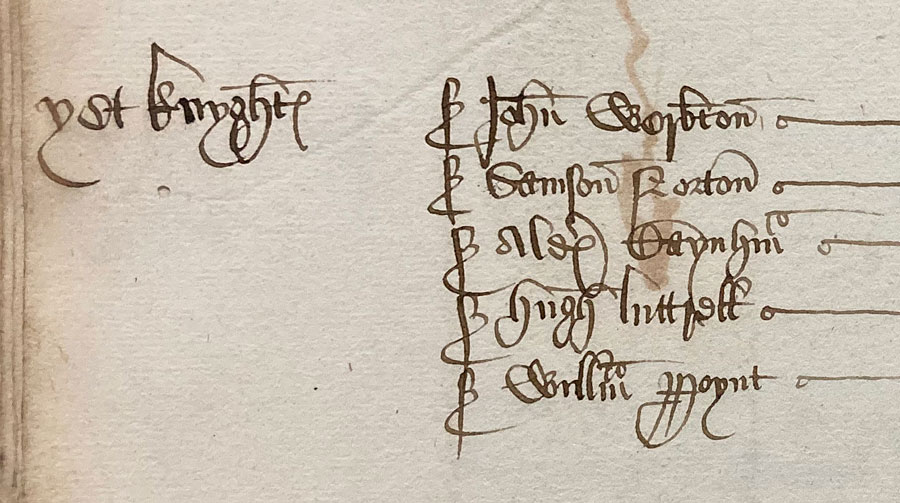
On 11th May 1509 he was a Knight in Attendance at the funeral of King Henry VII (his younger half-brother Christopher was also at the funeral, as a Squire for the Body).

Alexander is mentioned in other records such as a Royal Warrant issued in 1512: “Warrant to discharge Roger Mynors, Serjeant of the King’s Cellar, and Sir Alexander Baynham, with others, of all fines for writs used by them for recovering of lands in Counties Derbyshire and Staffordshire against John Kynaston for performance of the last will and other things necessary to the said Roger, who is appointed to attend the King in his voyage upon the sea”. Greenwich, 11 May. King’s Stamp.
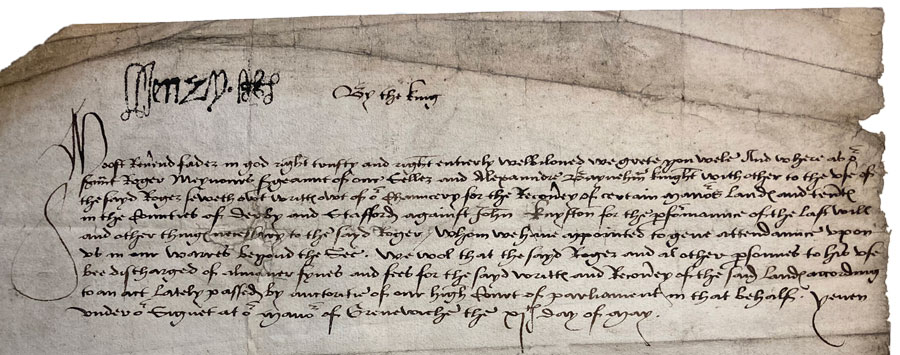
At this time King Henry VIII was preparing for war against France and began a recruitment campaign, drawing on two categories of men: noblemen and gentleman who served in person with their men and those who remained at home and provided troops. Alexander was in the former category and was included in a list headed “these persons whose names follow have the King’s letters sent to them to make and send the numbers following, and to certify by a day to serve the King’s grace by land” – he received a summons to attend with twenty men, as did his younger half-brother Christopher.
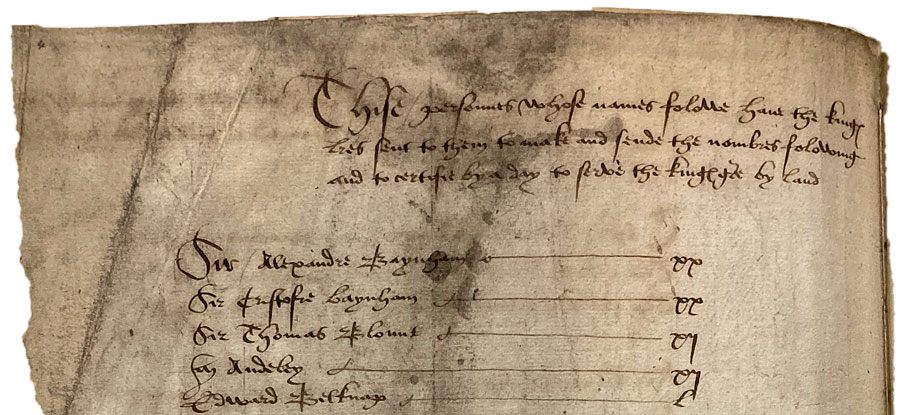
So, in anticipation going overseas to war in France, on 31st May 1513 (aged 54) Alexander made his first will.
The will dealt with his properties in Goucestershire and Herefordshire, in accordance with a feoffment (transfer to trustees) dated 17 May 1513. In it he stipulates that some of the properties should be used to make financial provision, including a dowry, for his wife Elizabeth; the potential future marriage of his daughter Jane (then aged about 20); and the education of his two younger sons, Thomas (18) and James (14). There is no additional provision for John (25), who is his eldest son and heir.
A few days later, Alexander and his men were on their way to board ships to France.
Henry’s army, including the non-fighting men, was divided into three parts: the fore-ward (around 12,000 strong), the middle-ward (16,000) and the rear-ward (7,500).
Alexander and his 103 men were in the rear-ward, under Charles Somerset, Lord Herbert, which began its crossing to Calais on 10th June.

By 16th June it was ready to move out and marched west to join the fore-ward at Marquise; from there they travelled together to Therouanne which they reached on 22nd and three days later they began the siege.
Therouanne was a strong and well-defended fortress-town on which the English cannon made very little impression; and any damage done to the walls during the day was usually repaired that night.
Also, with only half its fighting force in position, the besieging army was unable to prevent frequent raids by French light cavalry coming out and supplies and some reinforcements going in.

So the decision was taken to mine the walls.
The order was given to Sir Alexander, as captain of the pioneers of the rear-ward, to dig a mine that would demolish a section of wall wide enough to allow an assault force to enter Therouanne. The work went well, but, as the diary of Marino Sanuto attests, the French were able to monitor its progress and dig a counter-mine which they blew on 18th July, destroying the English mine and killing all the men working in it.
The King had not arrived in Calais until 30th June and had stayed there with the middle-ward, of which he was commander, until 21st July; so he did not reach Therouanne until 1st August.
Alexander’s younger half-brother Christopher was also in the army; he would have been a member of the middle-ward as he was an Esquire for the Body to King Henry at the time.
The arrival of the middle-ward meant that it was at last possible to surround the town – a factor which contributed towards the English victory in the Battle of the Spurs when yet another attempt to revictual the garrison from the south was thwarted and the French cavalry put to flight.
With no hope of survival, the garrison of Therouanne surrendered on 22nd August and left the following day. As a captain of pioneers, Alexander and his men would have been involved in the demolition of the fortress – filling in the ditches, pulling down the walls and burning all the buildings (except the cathedral and the houses of the clergy adjoining it).
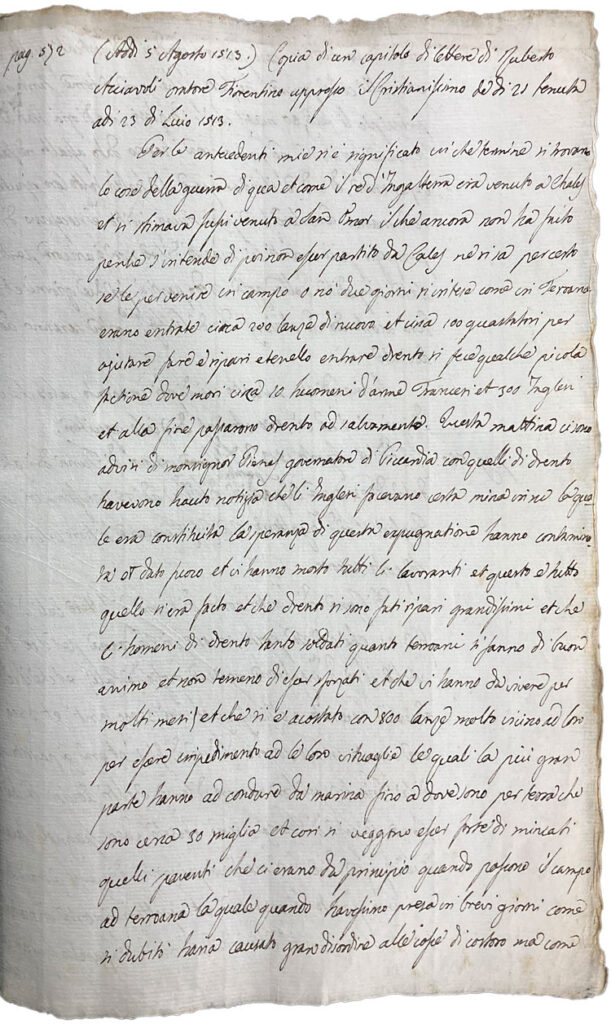
Next, at Maximillian’s request, Henry turned his attention to Tournai and began a siege there on 16th September; the town was a commercial hub with poor defences, no garrison and very little gunpowder, so it suffered under the English bombardment (some of the ‘apostles’, Henry’s favourite guns which he at times commanded himself, were with the rear-ward to the west of the town). It was not long before Tournai sued for peace – by 25th September, Henry and his men were making a ceremonial entry (in their finest outfits).
Alexander’s younger half-brother Christopher was knighted by Henry at Tournai.
In the ‘Expenses of the War’ are recorded ‘the indentures, bills and other evidences of payments made by Sir Robert Dymmoke, treasurer of the Rearward, by command of C. Somerset lord Herbert, captain general of the same, between June and October 1513’.
Among receipts, ‘signed by the captains, of the regular monthly wages of themselves and [their] men’ are three signed by Alexander.
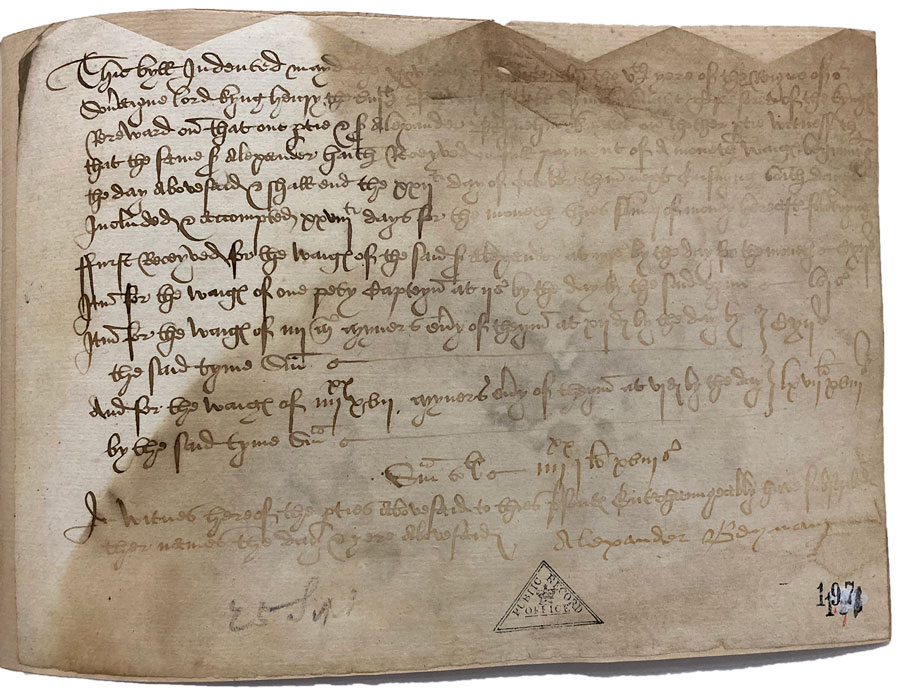

One receipt is almost illegible but the other two, despite evident water damage, show his signatures for those wages.

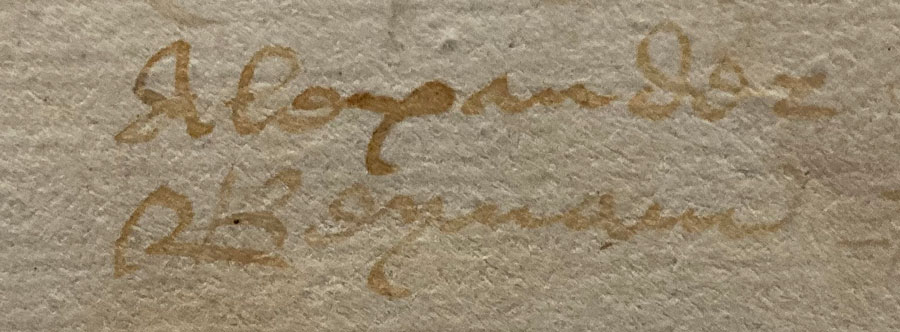
On his return to England, Alexander was again involved in county administration. In 1514, in the same document which granted a pardon and release as Sheriff of Gloucestershire to his half-brother Sir Christopher Baynham, Sir Alexander Baynham of Westbury (along with others) was released of his recognizance of 40l., which he had given on 10th November 1511, shortly after Christopher had taken up the office of sheriff for the first time.
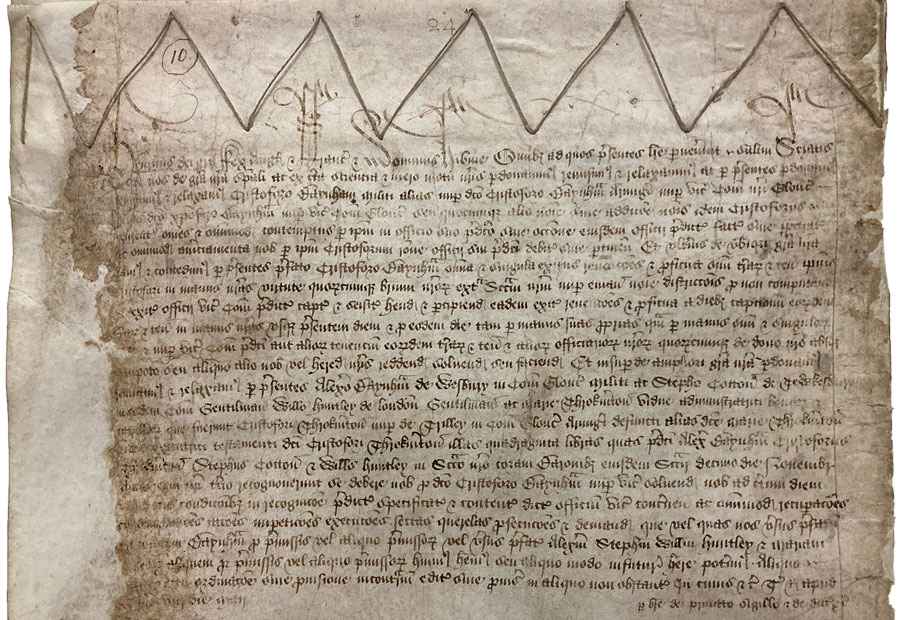
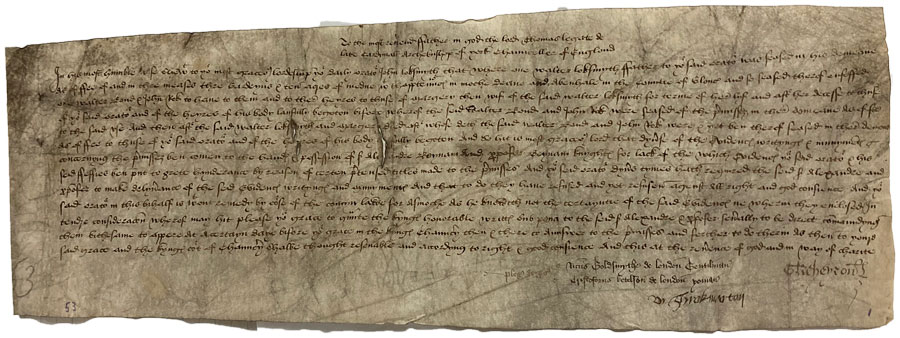
He was also a co-defendant with his younger half-brother Christopher in another case (Locksmyth v Baynham) in the Court of Chancery, Six Clerks Office, brought in 1515 by John, son of Walter Locksmyth regarding the detention of deeds relating to messuages and land in Mitcheldean and Abinghall, Gloucestershire.
In 1516 Alexander was appointed Sheriff of Gloucester for a sixth and final time – on 10th November, recorded as ‘Alexander Baynham knight’.

On 28th May 1517 Alexander received a commission, along with six others for Herefordshire, Worcestershire and Gloucestershire (including Sir Robert and Thomas Poyntz), “to make inquisition stating what towns and hamlets, houses and buildings, have been destroyed since Mich. 4 Hen. VII. [1488]; what and how much land then in culture has since been converted into pasture; the number of parks since inclosed, and the land added to parks then existing”.
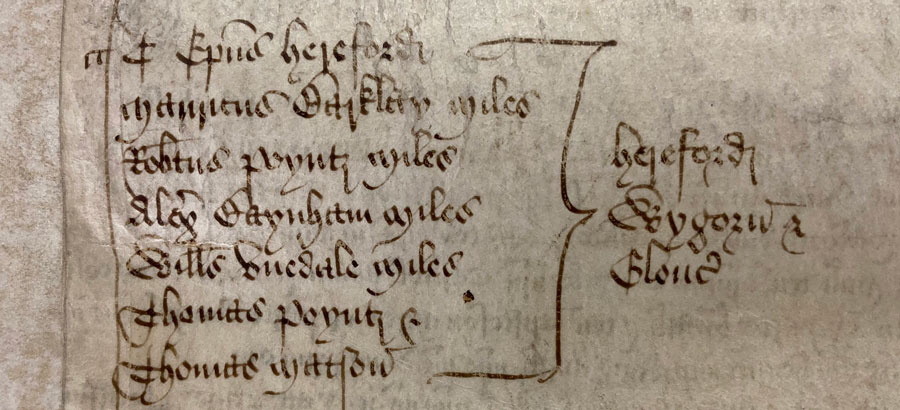
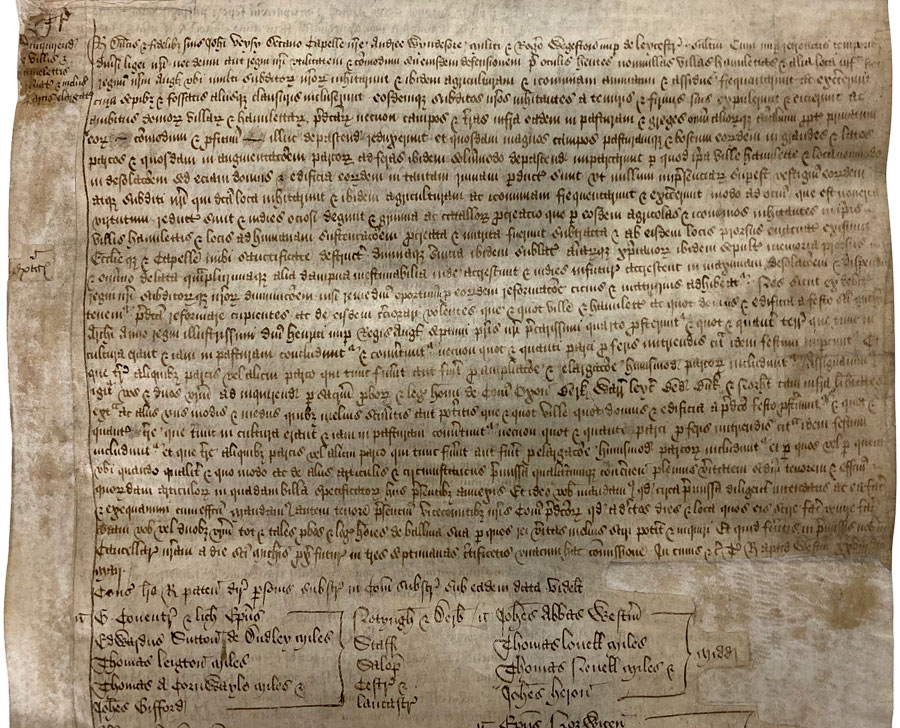
In 1518, in another case in Chancery (Clayton v Mile), Alexander was required to forfeit a bond which he had given on behalf of Harry Mile for the performance by Harry of his office as Sheriff of Herefordshire. The case was brought by William Clayton, under-sheriff of Hereford, against Alice, Harry’s widow, and Miles ap Harry who was Harry’s son and administrator; the bond had been given at Clayton’s insistence.
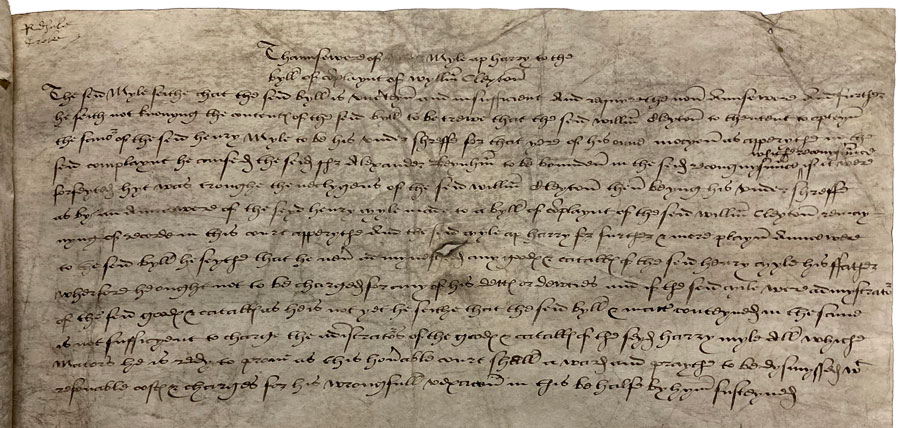
On 19th November 1520 Alexander received a commission, along with six others, to deliver the goal of Gloucester castle.

On 8th May 1521, an indictment in London at the Guildhall before the Lord Mayor and a Special Commission of Oyer and Terminer found that Edward Duke of Buckingham, late of Thornbury, Gloucestershire had committed treason.

A similar indictment found at Bristol Castle where the jury was comprised of twenty Gloucestershire men, including Sir Alexander Baynham and Sir Christopher Baynham.
‘In 1522 the King ordered a military survey of England, by county (the survey of Gloucestershire is one of the few to have survived). It was intended to record personal wealth in land and goods, items of military equipment such as suits of armour and weapons) and whether a man was fit for combat. Sir Alexander appears with a land value or as steward several times:
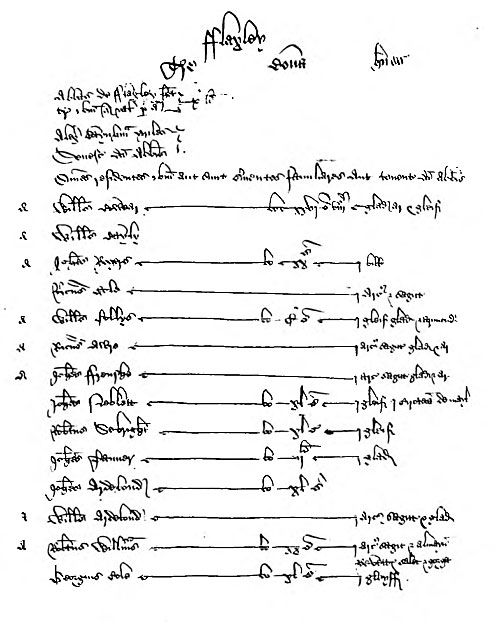
for Mitcheldean and Abenhall he appears at the top of the list as “lord of Mitcheldean and worth £20” followed by his half-nephew “George Beynam esq lord of Abenhall and is worth £15”, “Thomas More rector there and is worth £13 6s 8d” plus a further 101 men of varying worth who possess their own combinations of harness and almain rivets (types of armour), hauberks (shirts of chain mail), bows & arrows, swords & shields, daggers, lances, bills and other weapons, plus a few horses;
for Little Dean, the Abbot heads the list as lord (£6), Sir Alexander is steward (£4), then there are two clerks, a chaplain of the chantry and 58 others;
for Ruardean, there are Sir Alexander (£6) and his half-brother Sir Christopher (£14), a chaplain and 62 others;
for Flaxley (shown here), “the abbot of Flaxley has land there worth £10”, “Sir Alexander Baynham is the abbey’s steward” and “all [17] residents there are the servants, household and tenants of the abbot”;
Sir Alexander is also listed for Chesterton (£5 6s 8d) plus 3 others; Tarlton (£3) with Doctor Fysshmonger and the Abess of Romsey, plus 13 others; Fairford (£3 10s) ‘where the king is lord of the vill’ with Sir Edward Tame, the Prior of Bradenstocke and the Prioress of Studley, plus 23 others; Fretherne (steward) plus ——-, Ruddle (steward) plus ——–.
For Westbury on Severn, as well as a land value (£10), Alexander has a goods value (£100) as this is where he lives; he also has “harness for six men”.
A First Loan for the War in France based on the values in the Muster was levied by the king in the autumn of 1522.
Alexander is recorded as presenting to the Church of Deane Magna only once, on 16th January 1523: ‘Sir Thomas Beynham, Priest was admitted following the death of Thomas More, the last Rector, upon the presentation of Sir Alexander Beynham, Knt., the true patron’. Thomas More had been rector since late 1485 and had been recorded in deeds and documents as a participant in numerous transactions. Sir Thomas Baynham was Alexander’s nephew, the only son of his brother William and Eleanor Amerys.
After the First Loan, a parliamentary grant of 21st May 1523 imposed a Subsidy, also based on the values recorded in the Military Survey, which was intended to raise a total of £800,000 towards the cost of the campaigns in France; it was to be collected annually, for four years.
On 30th August 1523 Alexander was appointed to the commission to collect the first annual tranche of this subsidy in Gloucestershire.

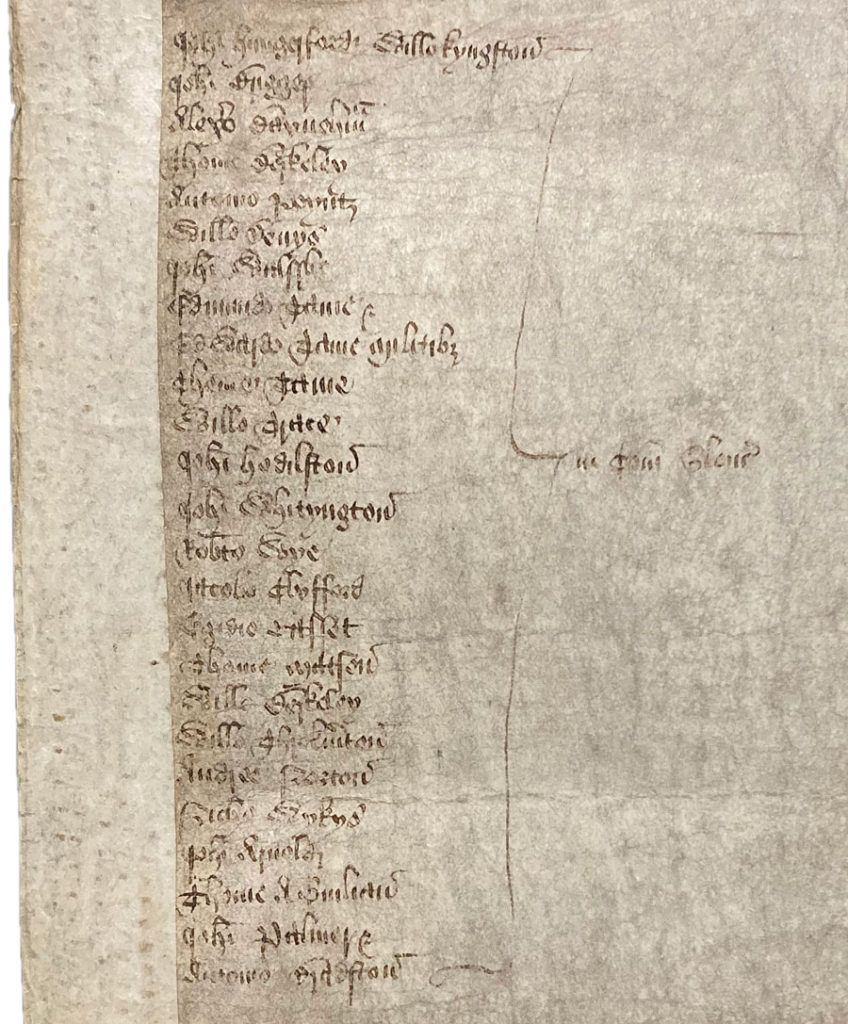
Meanwhile, Sir Antony Poyntz of Iron Acton, son and heir of Sir Robert Poyntz and Antony Bradstone, son and heir of Thomas Bradstone esquire of Winterbourne, had brought a case in the Six Clerks Court of Chancery against Sir Alexander Baynham, late sheriff of Gloucestershire ‘regarding the imperfect accounts by Alexander of the receipts of his sheriffwick’ for which Robert Poyntz and Thomas Bradstone had been his official sureties.
This appears to have been a formal precursor to the release on 9th November 1523 of Poyntz and Bradstone from the 40l. bond which their fathers had given for Alexander back in 1482, on his first appointment as sheriff.
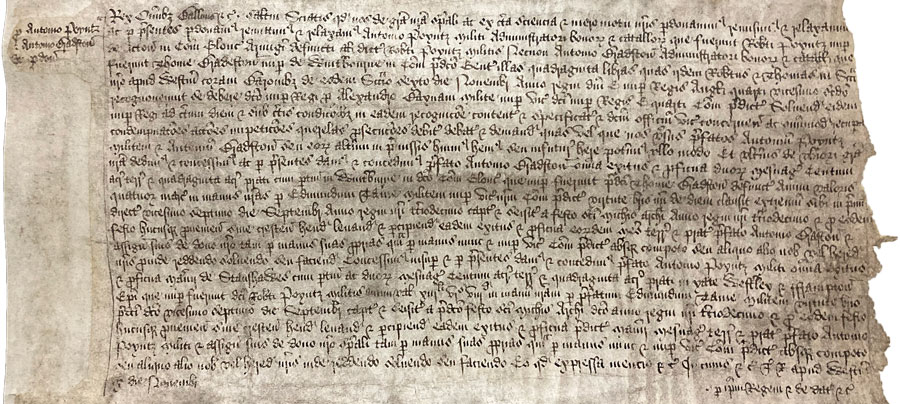
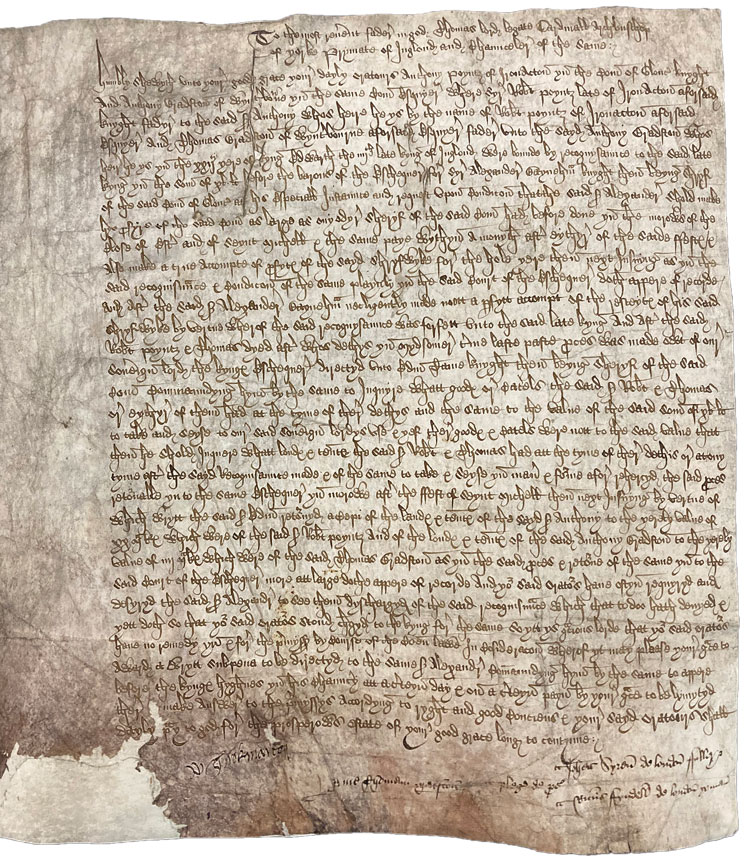

Returns from the first loan of 1522 had proved insufficient, so in the following year, the king raised a Second Loan for the War in France – between Michaelmas 1523 and 1st April 1524.
The finances for this loan are recorded in ‘The book of all the receipts and payments received and paid by Sir Henry Wiat Knight Treasurer of the King’s Chamber of the [ ] money paid into his hands by diverse collectors of several shires in the fourteenth year of the reigh of King Henry the Eighth’.
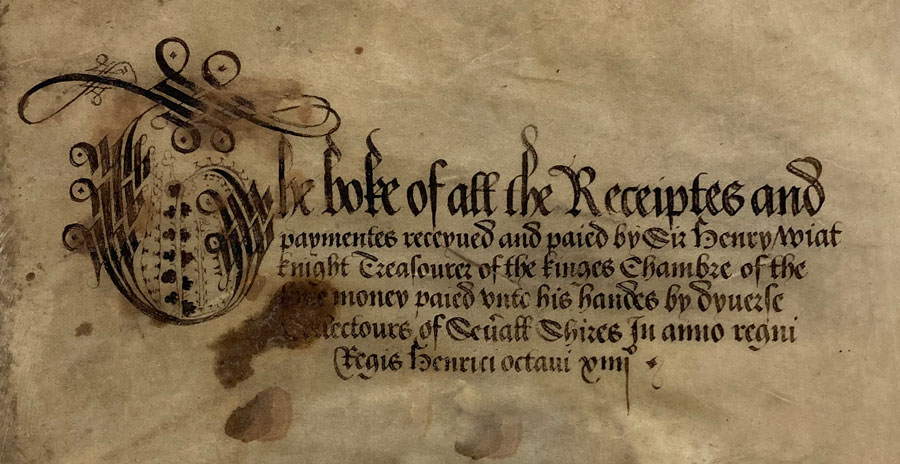
Alexander appears in the book as a collector for the period between 30th June 1524 and his death in September. The total collected for Gloucestershire from 30th June 1524 to 1st April 1525 was 837l. 6s.
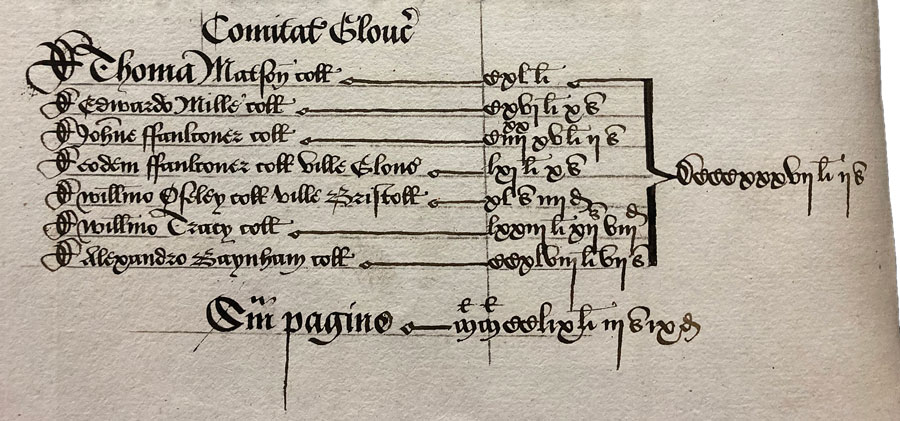

The book also includes payments made by Sir Henry Wyatt on behalf of the king to the collectors, to reimburse their expenses of collection and portage.

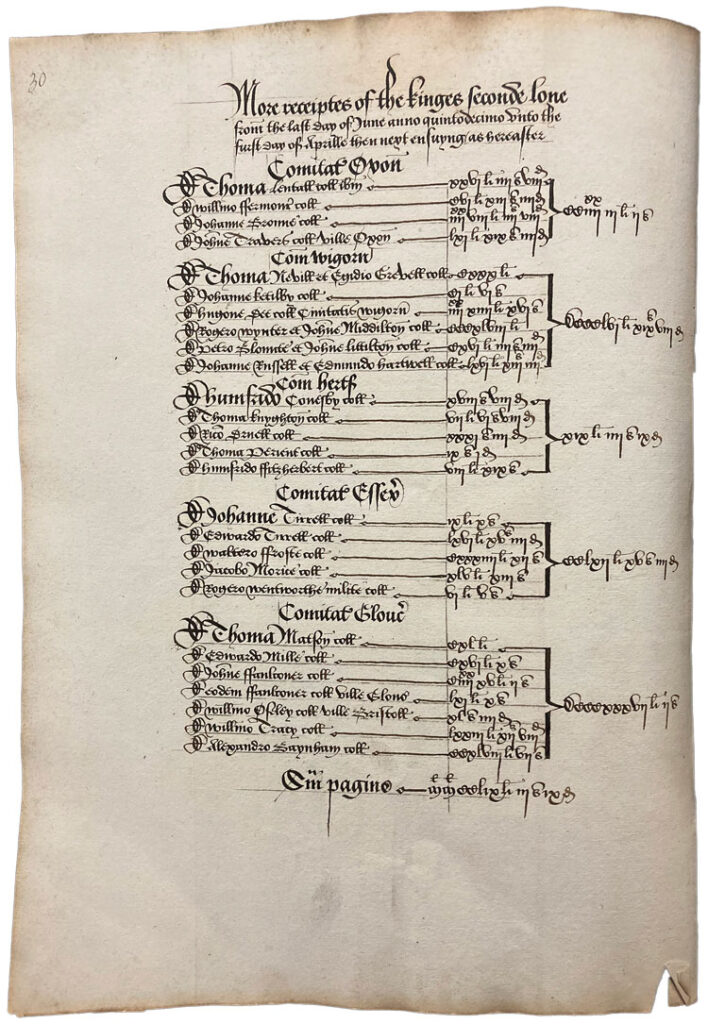
Alexander’s last official role appears to have been his appointment on 1st August 1524 as a commissioner to collect the second annual tranche of the subsidy in Gloucestershire.

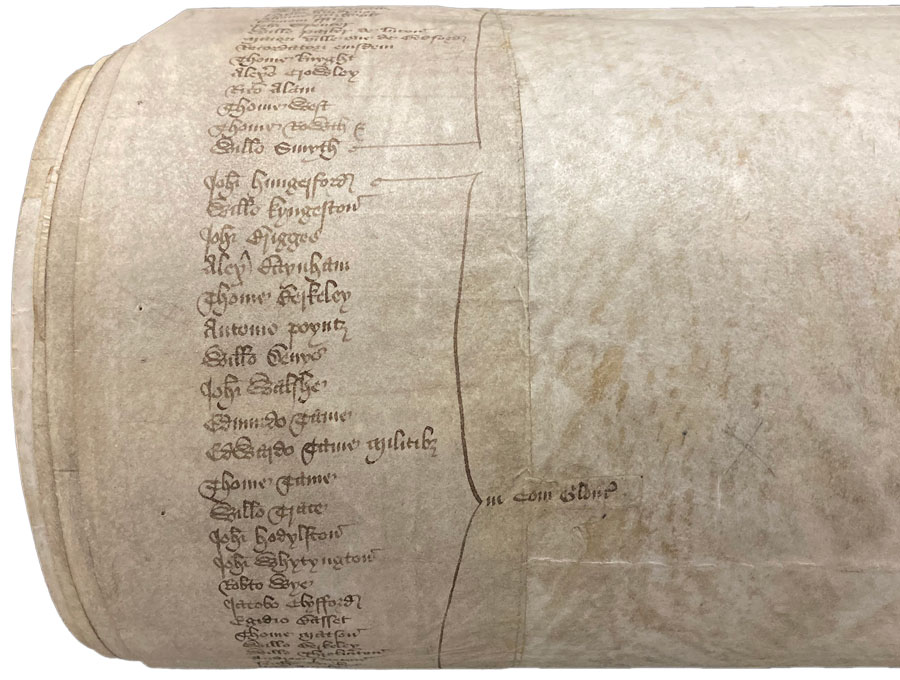
On 20th September 1524, just five days before he died, Alexander made a second will to deal with his goods and chattels (his properties had already been dealt with in his earlier will of 1513); he stated in this will that he was “ill in body” and expressed the wish to be buried “in the chapel of Blessed Mary of Westbury”. As well as leaving sums of money to the church in Westbury and a “house of brothers” in Gloucester, he left 200 marks to his daughter Jane and to his son Thomas he bequeathed “one young horse called Leyard”.
Alexander died in 1524 at Westbury On Severn, aged 65.
He was buried in St. Mary’s Chapel in the church of St. Peter and St. Paul in Westbury on Severn, as he had wished.
In the chapter entitled ‘Gloucestershire in the 1530s’ of her book ‘The English Reformation and the Laity: Gloucestershire 1540-1580’ Caroline Litzenberger describes Sir Alexander Baynham as “The head of the most prominent family in the Forest of Dean”.

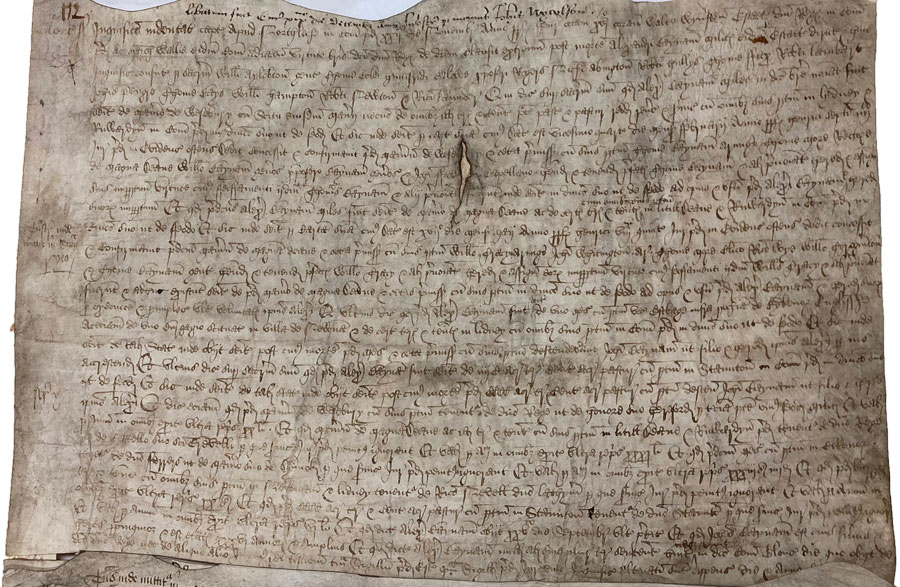
For Alexander’s properties in Gloucestershire, an Inquisition Post Mortem in Chancery was held was held at Northleach, Gloucestershire on 22nd November 1524.
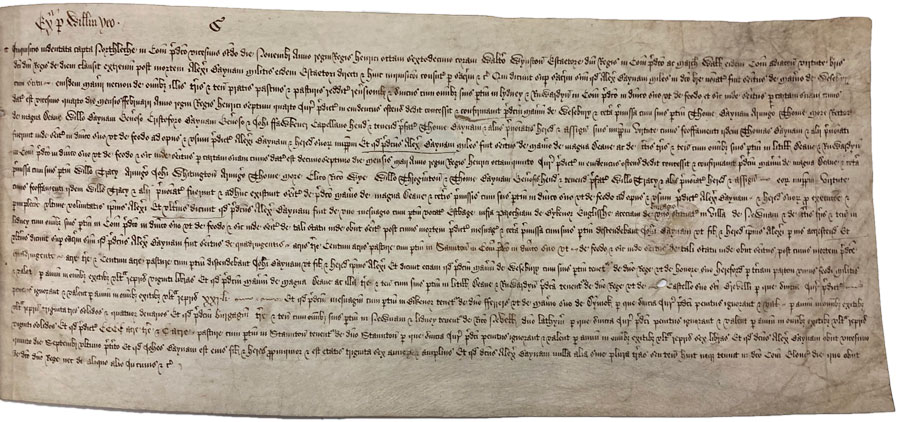
An Inquisition Post Mortem in Chancery for Alexander’s properties in Herefordshire was held was held at —————- on ———– 1524.
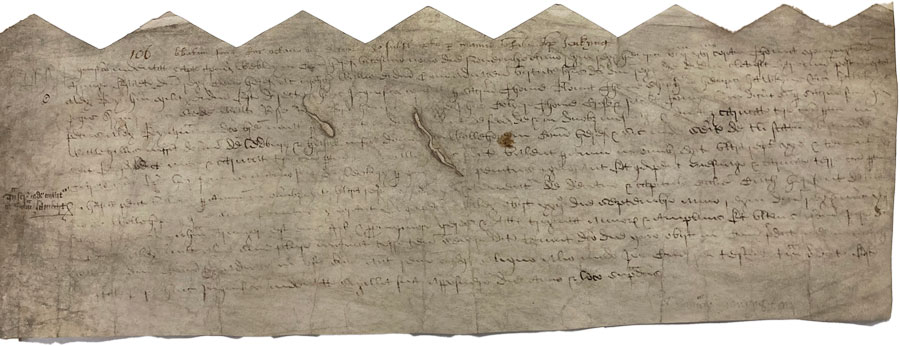

Alexander’s second wife Elizabeth survived him and died in 1527.
His eldest son and heir John also survived him, but only by four years – he died on 6th August 1528.
His youngest son James died at the stake in April 1532.
Elizabeth’s parents had settled the manor of Steeple Lavington on her and Alexander in 1494. This manor was inherited by their son Thomas, who made his will on ….. October 1532, shortly before he died unmarried and childless; his will was proved on 4th November 1532. In it he left ……………………………. to Sir Thomas Baynham parson of Mitcheldean …………………. and half shares of the manor to his sisters Margaret and Jane.
(Margaret died in 1554, leaving a will dated 26th June 1551 [proved 17th August 1554], but she had already sold her share of the manor to a William Willington in 1537. Jane sold her share in 1572, to a Robert Nicholas and his son Richard).
[ Was Alexander’s son Thomas the ‘Thomas Baynham’ who is a trustee mentioned in the licence granted to John Peyto to alienate lands …… to …… John Baynham, Th. Baynham, and ……………….. to hold during the life of Margaret, wife of the said John Peyto, to the use of himself, his wife, and his heirs. Westm., 12 Feb. Pat. 4 Hen. VIII ? he would have been about 18 year old. ]
[ Who is the ‘Sir Thomas Baynham parson of Mitcheldean’ mentioned in the 1532 will ? ]
[ Thomas’ will – PROB 11/24/53 ]
Notes:
There are no available membership records for Lyon’s Inn. Sir John Baker in his book ‘Men of The Court’ argues that evidence for Alexander’s membership is contained in the Plea Rolls of the Common Pleas from 1508, where he is included as ‘Alexr Baynam, knt’ in a list of men sued by the Inn for non-payment of fees – in his case £28. Late payment was commonplace, apparently; in Alexander’s case he appears to have been sued around 30 years after the debt was incurred!
Alexander was knighted by Richard Duke of Gloucester in 1482.
Was his personal coat of arms ‘Gules, a lion passant ermine’? (see 14 HSNS 13, cit. William Ballard’s Roll of Arms, at the British Library)
When and how did the Baynham arms become ‘a shield charged with a chevron between three bulls’ heads carbossed’?
Giles Brugges of Cowberly (or Brydges of Coberley) became Alexander’s brother in law when he married his half-sister Isabel Baynham around this time.
1505 wardship …………
The Tudor Regime by Penry Williams, p.112 + State Papers Domestic, Henry VIII (SP 1), 1/2 ff. 111-14; 1/229 ff.48-52 (LP 1. i. 1176)
The church appears in records from 1100, but the detached tower and spire were not built until the 13th Century and the body of the church was totally rebuilt in the 14th Century (and later restored on several occasions). The chantry dedicated to St. Mary was founded before 1407 and stood against the east face of the tower. It was demolished in 1862; a doorway leading from it into the tower survives, as does a weather-moulding (one of two on the side of the tower) from re-roofing carried out in 1779.
Acknowledgements:
- 1482 Alexander Baynham knighted by Richard Duke of Gloucester – British Library, Cotton MS Claudius C. iii. ff. 68-144
- 1482 Appointment of Alexander Baynham as Sheriff of Gloucestershire – National Archives, C 60/291, m. 5
- 1483 (April) Appointment of Alexander Baynham as Sheriff of Gloucestershire – National Archives, C 60/292, m. 2
- 1483 (June) Appointment of Alexander Baynham as Sheriff of Gloucestershire – National Archives, C 60/293, m. 12
- 1484 Pardon to Alexander Baynham of all offences committed as sheriff – National Archives, C 66/556, m. 15
- 1484 Appointment of Alexander Baynham as Commissioner of Array – National Archives, 66/553 m. 20d
- 1486 Appointment of Alexander Baynham as Constable of St. Briavels Castle – National Archives, C 66/563 m. 22(6)
- 1488 Alexander Baynham entered into a bond payable to the king – National Archives, C 54/349, m. 4d (item. 376)
- 1488 Commission to Alexander Baynham to take a muster of archers – National Archives, C 66/569, m. 12 (20)d
- 1489 Commitment to Alexander Baynham by Mainprise – National Archives, C 60/299, m. 11
- 1491 Enfeoffment of Alexander Baynham by Morgan & Lucy Thomas – National Archives, C 54/352, m. 11d (item 604)
- 1492 Alexander Baynham included in arrangements for the Treaty of Etaples – British Library, Cotton MS Julius B. i. ff. 93 b. & 94 b.
- 1493 Action in Court of Common Pleas in the name of Alexander Baynham and others – National Archives, CP 40/296/269
- c.1493 Alexander Baynham appears as defendant in Mors v Baynham and Aylouth v Baynham – National Archives, REQ 2/10/63 & 2/11/124
- 1494 IPM of Robert Russell Snr. shows enfeoffment of Alexander Baynham by him – National Archives, C 142/9/17
- 1495 Promise by John Berewe to enfeoff Alexander Baynham – National Archives, C 54/355, m. 20d (item 846)
- 1495 Alexander Baynham and others received a Remise and Quitclaim from John Berewe – National Archives, CP 25/1/79/96, m. 20
- 1498 Appointment of Alexander Baynham as Sheriff of Gloucestershire – National Archives, C 60/309, m. 11
- 1498 Commitment to Alexander Baynham by Mainprise – National Archives, C 60/309, m. 13
- 1498 Re-grant to Alexander Baynham of office of Constable of the castle of St. Briavels – National Archives, C 66/584, m. 6
- 1500 Licence granted to Alexander Baynham to enter onto his father’s lands – National Archives, C 66/586 m. 20 (8)
- 1501 Alexander Baynham shown as witness to Release and Quitclaim by John Clynton – National Archives, C 54/361, m. 21d item 61
- 1501 Alexander Baynham included in arrangements for the arrival of Catherine of Aragon – British Library, Cotton MS Vespasian C. xiv. f. 81
- 1502 Appointment of Alexander Baynham as Sheriff of Gloucestershire – National Archives, C 60/313, m. 17
- 1504 Letter from Alexander Baynham as Sheriff – National Archives, C 131/88/1
- 1505 Alexander Baynham granted wardshop of Anne Mathew – National Archives, C 66/597, m. 21 (16)
- 1506 Appointment of Alexander Baynham to Commission of Enquiry – National Archives, C 66/600, m. 4 (20)d
- 1507 Alexander Baynham made Recognizance to the king – National Archives, C 54/371, m. 23d (item 707)
- 1507 Alexander Baynham added to list of recognizors for safe keeping of Guysnes Castle – National Archives, C 54/372, m. 17d (item 767)
- 1508 Alexander Baynham included in proceedings brought by Lyon’s Inn for unpaid fees – National Archives, CP 40/983, m. 46
- 1509 Alexander Baynham as Knight in Attendance at funeral of Henry VII – National Archives, LC 2/1, f. 130
- 1512 Warrant of Discharge issued to Alexander Baynham – National Archives, 82/378, m. 26
- 1512 Call to Arms issued to Alexander Baynham – SP 1/2, f. 111
- 1513 First will of Alexander Baynham – National Archives, PROB 11/21/469
- 1513 Alexander Baynham listed as captain in rear-ward with 103 men – British Library, Lansdowne MS 818 f. 3
- 1513 Alexander Baynham mines walls of Therouanne, recorded in diary of Marino Sanuto (translated) – National Archives, PRO 31/14/129
- 1513 Receipts for soldiers’ wages signed by Alexander Baynham – National Archives, SP 1/6, ff. 1-259
- 1514 Alexander Baynham released from recognizance for half-brother Christopher as sheriff – National Archives, C 66/622, m. 10
- 1515 Alexander Baynham named as co-defendant in case of Locksmyth v Beynam – National Archives, C 1/425/53
- 1516 Appointment of Alexander Baynham as Sheriff of Gloucestershire – National Archives, C 82/440
- 1517 Appointment of Alexander Baynham as Commissioner of Inquiry – National Archives, C 66/630, m. 6d
- 1518 Alexander Baynham forfeits bond in case of Clayton v Mile – National Archives, C 1/486/10
- 1520 Commission to Alexander Baynham and others to deliver the goal of Gloucester castle – National Archives, C 66/636, m. 14d
- 1521 Inclusion of Alexander Baynham as juror at indictment of Duke of Buckingham at Bristol castle – National Archives, KB 8/5, m. 13
- 1523 Appointment of Alexander Baynham to Commission of Subsidy (collection of 1st tranche) – National Archives, C 66/642, m. 13 – 20d
- 1523 Case of ‘imperfect sheriff accounts’ against Alexander Baynham brought by Poyntz and another – National Archives, C 1/558/30
- 1523 Release of Poyntz and another as sureties for Alexander Baynham as sheriff – National Archives, C 66/642, m. 10
- 1523-4 Finance Book showing Alexander Baynham as collector of Second Loan and receiver of expenses – National Archives, E 36/221
- 1524 Appointment of Alexander Baynham to Commission of Subsidy (collection of 2nd tranche) – National Archives, C 66/645, m. 1d – 8d
- 1524 Second will of Alexander Baynham – National Archives, PROB 10/3
- 1524 Probate of 1513 Will of Alexander Baynham – National Archives ……………………..
- 1524 Inquisition Post Mortem (Herefordshire) of Alexander Baynham, in Chancery – National Archives, C 142/42/106
- 1524 Inquisition Post Mortem (Herefordshire) of Alexander Baynham, Exchequer copy – National Archives, E 150/425/8
- 1524 Inquisition Post Mortem (Gloucestershire) of Alexander Baynham, in Chancery – National Archives, C 142/42/112
- 1524 Inquisition Post Mortem (Gloucestershire) of Alexander Baynham, Exchequer copy – National Archives, E 150/358/6
- 1528 Probate of 1524 Will of Alexander Baynham – National Archives ……………………..
- 1532 Will of Thomas Baynham – National Archives ……………………..
- 1532 Probate of the 1532 Will of Thomas Baynham – National Archives ……………….
- 1551 Will of Margaret Baynham – National Archives ……………………..
- 1554 Probate of the 1551 Will of Margaret Baynham – National Archives …………………….
- c. 1480 Lyon’s Inn membership – Men of The Court (1440-1550) by Sir John Baker
- 1485 Battle of Bosworth Field – The Ballad of Bosworth Fielde, Bishop Percy’s Folio Manuscript. Ballads and Romances, ed. J. W. Hales and F. J. Furnivall (London 1868)
- 1512 Roger Mynors – The Old Halls, Manors and Families of Derbyshire by Joseph Tilley, p.69 mentions Sir Roger Mynors of Duffield. He was the eldest son of Richard Mynors of Treago, Herefordshire; he was knighted in 1527.
- 1513 The War In France – Henry VIII And The Invasion of France by Charles Cruickshank
- 1522 Military Survey – Military Survey of Gloucestershire 1522 by Prof. Richard W. Hoyle, Gloucester Record Series vol. 6
- “The head of the most prominent family in the Forest of Dean” – The English Reformation and the Laity: Gloucestershire, 1540-1580 by Caroline Litzenberger, p.31 and n.27
- Genealogy and general information – National Archives, British History Online, Victoria History of the County of Gloucestershire, Transactions of the Bristol and Gloucestershire Archaeological Society (Volume 6, which includes details of the Heralds Visitation of Gloucestershire in 1632 and an extract from The History of the Manors of Dean Magna and Abenhall by Sir John Maclean)
